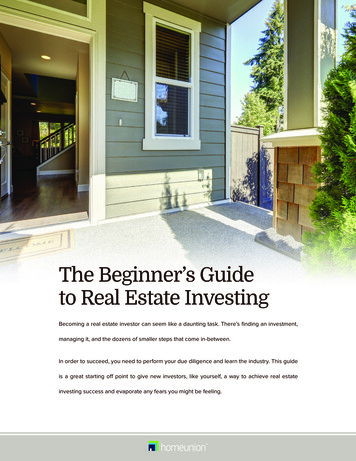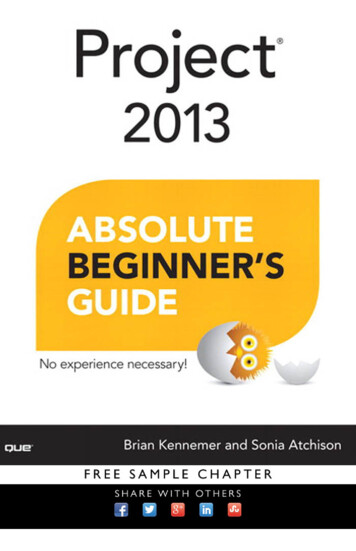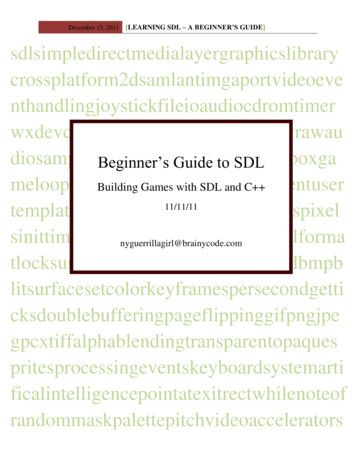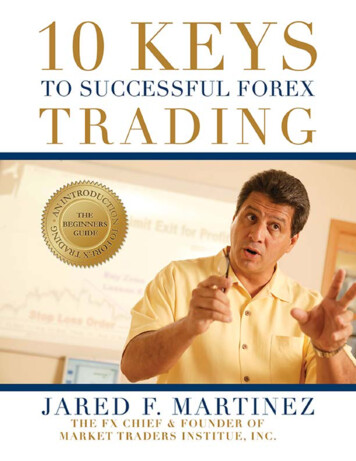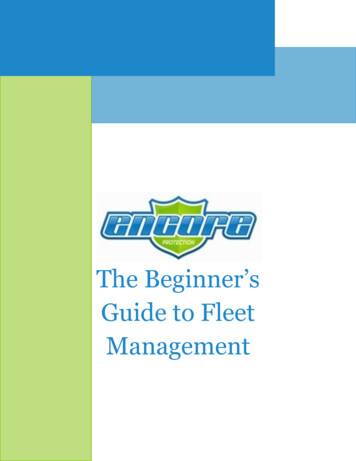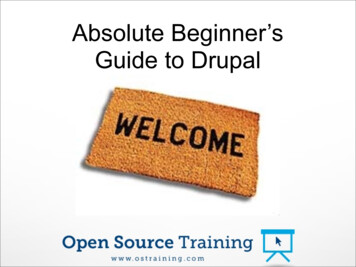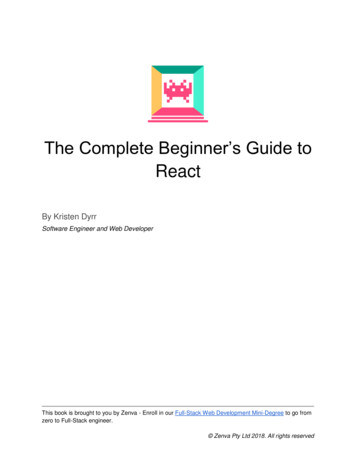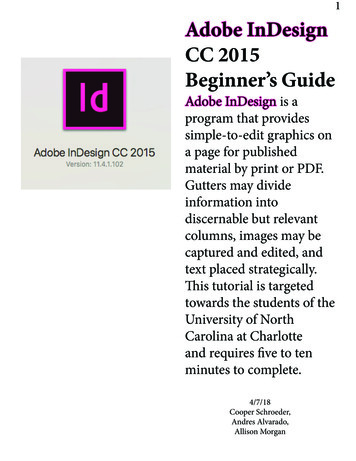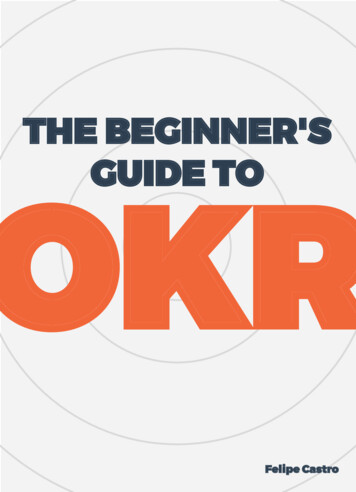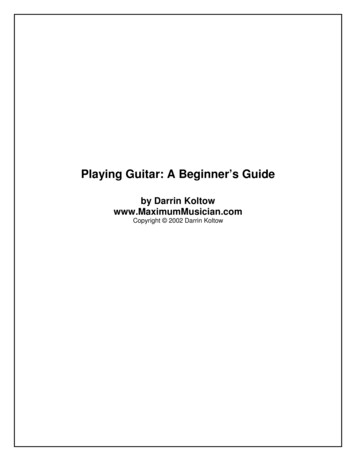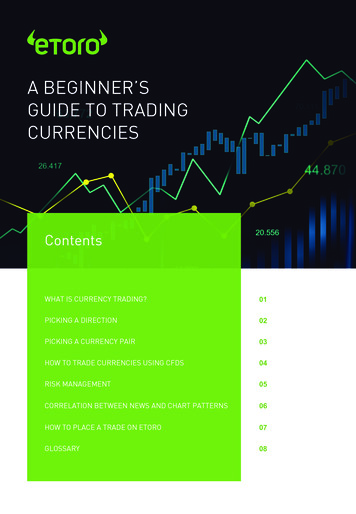
Transcription
A BEGINNER’SGUIDE TO TRADINGCURRENCIESContentsWHAT IS CURRENCY TRADING?01PICKING A DIRECTION02PICKING A CURRENCY PAIR03HOW TO TRADE CURRENCIES USING CFDS04RISK MANAGEMENT05CORRELATION BETWEEN NEWS AND CHART PATTERNS06HOW TO PLACE A TRADE ON ETORO07GLOSSARY08
What is currency trading?Currencies, or forex (foreign exchange, FX), is the trading of the 180 official world currencieson global financial markets. Some 5tn is traded every day, dwarfing what is bought andsold in stocks and bonds, and, due to their international nature, currency markets only sleepon weekends rather than close overnight.Some 95% of currency trades are made by investors and speculators, who use publicly available information tomake predictions about how a currency will move against others. Companies that operate internationally alsouse foreign exchange markets to create a buffer against a surge or drop in their home currency to smooth outtheir expected outgoings.Exchange rates are the same for everyone, regardless of size and sophistication, and are set by the marketitself. There are two rates, buy and sell, which are shown on the eToro currency pair page, along with the latestavailable price data.Image: eToro Trade Markets Currencies pageUnlike stocks and bonds, which are traded on specific results and company outlooks, foreign exchange isdriven by sentiment. If the market has confidence in a country’s economic future, its currency will rise in value.If the outlook is less certain, its currency will fall.The way currencies are traded is different to other securities and the value of holdings can change rapidly, too,but the size of these markets and the number of participants operating in them mean positions can usually besold quickly.As one of the world’s most popular retail investment platforms eToro makes currency trading straightforwardand offers a range of risk management tools to avoid building up losses, while optimising potential returns.A beginner’s guide to trading currencies PG 01
Picking a directionThere is one main way to trade forex: decide how you think a currency is going to move – up or down – andhow quickly.If a country’s economy seems to be on the up, its currency maybe set to strengthen. If it is having issues, itcould lose traders’ confidence and see its currency slip.Using data from national or regional central banks, governments and other official institutions can helpcurrency speculators gauge which way a nation’s fortunes may be set to move. The news feed on thecurrencies home page featuring eToro’s popular investors is a good resource to help guide you towards wherethis information can be found and explain how to interpret it.Image: eToro Popular Investor, Wayne Ryan (@goodgoing) commentary on currenciesTraders should be aware that currency movements are not all one-way traffic. What goes up can come downagain at a moment’s notice, so it is important to stay on top of the news.For example, if a country’s currency is getting very strong, it could find its exports are too expensive forinternational clients to buy and its companies begin to suffer. In this case, its central bank may step in to tryand curtail the rise of the currency by hiking interest rates to put the brakes on its economy.Equally, if a currency is weakening too far and inflation is picking up on imported goods, governments haveother levers to pull that can support its national economy.A beginner’s guide to trading currencies PG 02
Picking a currency pairOnce you have decided on the direction of the currency you want to trade, the next step is to find it a partner.Currencies are traded in pairs on a relative, rather than an absolute basis, with the difference between the twomaking a return or a loss.Historic datasets showing the movement of all tradeable currency pairs are available on eToro’s platform,along with the current market sentiment around the direction of the trade.Image: eToro chart showing EURUSD (1-day view)Popular investors also offer insight incommentary that is linked to currency pairs onthe platform. The trader must decide which ofthe pair is going to move the most significantlyagainst the other and set a prediction.If a trader thinks they will need less of theirbase currency to buy its pair in the future, theyselect the ‘buy’ tab on the eToro trade screen.Image: eToro EURUSD - buy and sell options screenA beginner’s guide to trading currencies PG 03
The trader can also decide that a currency is going to drop against its pair, so execute a sell order of its basecurrency, by selecting the ‘sell’ tab, with the intention to buy back in after a drop in value.When choosing the pair, it is worth noting that some are more actively traded than others and are thereforemore likely to see constant, gradual movement. The most commonly traded pair is USD/EUR, relating to theworld’s two largest trading blocs, but USD/GBP, EUR/JPY are highly active, too.Below is a table of tradeable currencies and its symbol, country or location, and nickname.SYMBOLCOUNTRYCURRENCYNICKNAMEUSDUnited GBPGreat aDollarLoonieAUDAustraliaDollarAussieNZDNew ZealandDollarKiwiCurrencies that are less commonly paired, such as NOKNZD (Norweigan Krone and New Zealand Dollar),may experience fewer but more significant swings in relative value.How to trade currencies using CFDsOn foreign exchange markets, many transactions arecarried out with traders never receiving any physicalcurrency. These transactions centre on how onecurrency moves against another without assets everchanging hands.Instruments known as contracts for difference (CFDs)allow traders to set where they think the price of onecurrency might move to against another. By applyingleverage – or borrowing from the trading platform –they can add weight to their trade.When activating a position using a CFD, a trader usingthe eToro platform will be asked the amount they wishto trade. The exchange rate is set by the market.Image: eToro EURUSD - trade screen.A beginner’s guide to trading currencies PG 04
Traders can then opt to add leverage to their position to increase their exposure to the movement of thecurrency. This will increase the profit – or loss – they stand to make once the trade has been opened on theeToro platform. The current leverage limit is X30.The trader then sets the parameters around where they think their base currency will move against its pairand must set a range of risk management tools to enable the position to go live.Unlike spread-bets, CFDs do not have a fixed expiry date so keep a trader’s position open until they decide toclose the trade.Those looking for long-term holdings, however, need to consider the impact of interest rates on each side ofthe currency pair. Even if the chosen side moves against its pair in the way a trader wants, either paying outor losing valuable interest – or carry – compared to the other currency can wipe out relative returns. This iscalled the rollover rate or swap fee.Risk managementThere are a range of risk management devicesavailable to traders, and eToro’s platform engagestwo of the most useful tools before allowing tradesto be made.Stop losses are a vital part of the currency trader’stoolkit and prevent losses building up if a currencymoves the wrong way by essentially cutting theengine to the trade by closing the position.This is important when traders are using leverageas losses can mount quickly. A stop loss can be aslittle as 0.5% of the initial, pre-leverage outlay, witha maximum for eToro customers at 50%. Traderscan extend this maximum once the position is openby adding to the invested amount being put at riskImage: eToro EURUSD - trade screen showing stoploss options and take profitfrom their account balance.A beginner’s guide to trading currencies PG 05
A trailing stop loss can also be added to a trade. This reduces the amount the trader is willing to lose in linewith the upward movement and gains made in the base currency. It thereby protects against losing anyprofits that have already been made.On the other side, traders can lock in where they want to cash out of a trade by setting a ‘take profit’ level.This level can be up to 1,000% of the initial pre-leveraged outlay.These risk management measures are set when the trade is opened, and they kick in automatically as themarket moves to give traders piece of mind when they are not active on the platform.Correlation between news and chart patternsUnexpected news can have a significant impact on markets, which means there are opportunities and risksaround every corner.Getting a feel for how markets react to even expected information can help shape a currency strategy, too.Being agile and alert to global – and local – events can mean being able to capitalise on economic shifts thatfilter through currency markets before making an impact on other types of trading.Reading through historical currency pair charts, which are available on the eToro platform, and matching itup to data releases and other significant global events can help traders position portfolios so they are readyto move when markets do.Image: eToro Chart showing EURUSD historical pair data (1-month view)Learning from popular investors is also a good way to start navigating currencies and with eToro, automaticrisk management tools ensure traders are not caught out when markets turn against them.A beginner’s guide to trading currencies PG 06
How to place a trade on eToroTo place a currency trade on etoro, simply:§ Login or create an account by going to www.etoro.com§ Head to Trade Markets and select Currencies to access the full list of pairs§ Select the currency pair you wish to buy or sell, then select Trade§ Then select buy (1) or sell (2)§ Enter the amount (3) or number of units (4) you wish to trade§ Adjust the stop loss (5), leverage (6) and take profit (7)§ Select Open TradeA beginner’s guide to trading currencies PG 07
Glossary§ASK - is the price you get when you buy§BID - is the price you get when you sell§BUY OR LONG - buying a particular currency§CANDLESTICK - representation of themovement in that time period§CFD - contract for difference - trading an assetwith leverage§CLOSE - the point the candlestick finishes§ECONOMIC CALENDAR - a calendar with allthe latest news announcements§FOREX - short for foreign exchange orcurrencies market. It is the exchange of onecurrency for another§INVESTMENT - the amount of money you aretrading with§INVESTOR - someone who typically holdspositions in an asset for months or years§LEVERAGE - allows you to buy an asset withoutpaying full asking price§PIPS - is the measurement of movement in themarket§REWARD - amount of money that can be madeon a trade§RISK - the amount of capital exposed on anysingle trade§RISK MANAGEMENT - managing the exposureon your account/trade§SELL OR SHORT - selling a particular currency§SPREAD - the cost of placing the trade, thedifference between the bid and ask price§STOP LOSS - is the cut off point for a trade.You’re not prepared to be in a trade past thispoint§TAKE PROFIT - the point where you take theprofit out of the market§TRADING PLAN - a guideline of when to be inand out of the marketThis publication is considered a marketing communication and as such, it does not contain and should not be taken as containing,investment advice, personal recommendation, or an offer of or solicitation to buy or sell any financial instruments. This publication has notbeen prepared in accordance with the legal and regulatory requirements to promote independent research. In producing this material,eToro has not taken any particular investment objectives or financial situation. Any references to past performance of a financial instrument,a financial index or a packaged investment product are not, and should not be taken as a reliable indicator of future results. eToro makes norepresentation and assumes no liability as to the accuracy or completeness of the content of this publication, which has been preparedutilising publicly-available information. This communication must not be reproduced without consent from eToro.eToro is a multi-asset platform which offers both investing in stocks and cryptoassets, as well as trading CFDs.CFDs are complex instruments and come with a high risk of losing money rapidly due to leverage. 75% of retail investor accounts lose moneywhen trading CFDs with this provider. You should consider whether you understand how CFDs work, and whether you can afford to take thehigh risk of losing your money.A beginner’s guide to trading currencies PG 08
A beginner’s guide to trading currencies PG 06. To place a currency trade on etoro, simply: §Login or create an account by going to www.etoro.com §Head to Trade Markets and select Currencies to

